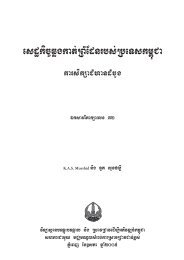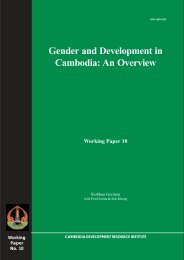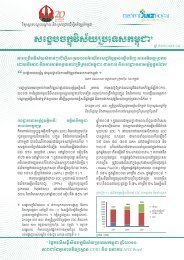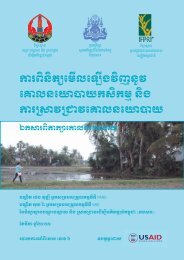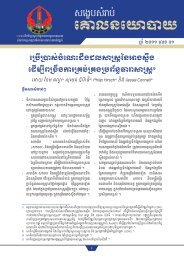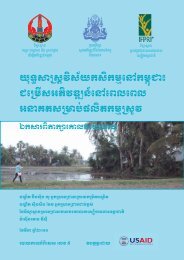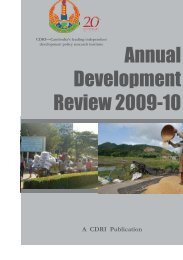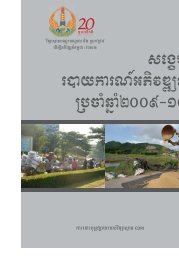62) decentralised governance of irrigation water in cambodia - CDRI
62) decentralised governance of irrigation water in cambodia - CDRI
62) decentralised governance of irrigation water in cambodia - CDRI
Create successful ePaper yourself
Turn your PDF publications into a flip-book with our unique Google optimized e-Paper software.
To recap the discussion on the complexity <strong>of</strong> <strong>water</strong> scarcity (see Literature Review), <strong>in</strong><br />
Cambodia there is not only an “economic scarcity” but <strong>in</strong> some cases, a “physical scarcity”<br />
as well. For example, <strong>in</strong> the north western region <strong>of</strong> Rolous (near Boeung Lies) <strong>water</strong> is<br />
physically scarce at the sub-scheme level and economic scarcity (i.e. severely underdeveloped<br />
<strong>in</strong>frastructure) compounds the issue for farmers. Here, farmers are aware where their ISF<br />
payments go – the development and ma<strong>in</strong>tenance <strong>of</strong> <strong>in</strong>frastructure – but <strong>in</strong> a number <strong>of</strong> cases<br />
they simply cannot pay it due to low agricultural yields result<strong>in</strong>g from <strong>water</strong> scarcity. There<br />
is an <strong>in</strong>tr<strong>in</strong>sic shortage <strong>of</strong> <strong>water</strong> <strong>in</strong> DAP – even upstream users feel that there is not enough<br />
<strong>water</strong> – and distribut<strong>in</strong>g it from upstream schemes to DAP is not feasible because there are no<br />
concrete canals between the schemes, and to allow the <strong>water</strong> to flow through the natural river<br />
would result <strong>in</strong> substantial losses through <strong>in</strong>filtration and evaporation.<br />
This task <strong>of</strong> improv<strong>in</strong>g the <strong>in</strong>frastructure would not be feasible if left solely to the<br />
newly-established FWUCs. Both externally sourced f<strong>in</strong>ancial capital and technical support are<br />
required <strong>in</strong> the beg<strong>in</strong>n<strong>in</strong>g, with the management functions ideally be<strong>in</strong>g transferred to the local<br />
committee as soon as their capacity is adequately developed. A key factor to keep <strong>in</strong> m<strong>in</strong>d is<br />
that the participatory approach at community level is alien to Cambodian culture and needs to<br />
be planted <strong>in</strong> the m<strong>in</strong>ds <strong>of</strong> the local populace and nurtured before it can become <strong>in</strong>dependent,<br />
self-reliant, and left to grow on its own. The Rolous case is one example where the <strong>in</strong>troduction<br />
<strong>of</strong> the participatory approach has not been adequately nurtured. The FWUC here is f<strong>in</strong>ancially<br />
weak, has no discrete power, and lacks capacity to undertake the development and ma<strong>in</strong>tenance<br />
<strong>of</strong> the <strong>in</strong>frastructure.<br />
As the development <strong>of</strong> new <strong>in</strong>frastructure at scheme or sub-scheme level is <strong>of</strong>ten expensive<br />
and <strong>in</strong> order to provide immediate benefits for farmers’ livelihoods, it may be more effective<br />
for the FWUC to focus its efforts on the development and ma<strong>in</strong>tenance <strong>of</strong> <strong>irrigation</strong> systems on<br />
a smaller scale. Such small-scale projects may <strong>in</strong>volve the mobilisation <strong>of</strong> farmers to complete<br />
the development and repair <strong>of</strong> tertiary canals and dra<strong>in</strong>age <strong>in</strong>frastructure, which accord<strong>in</strong>g to<br />
<strong>in</strong>terviews with farmers would meet their immediate needs. The f<strong>in</strong>d<strong>in</strong>gs demonstrate that some<br />
co-ord<strong>in</strong>ation by the FWUC is required because if left to their own devices, farmers would<br />
likely be unable to co-ord<strong>in</strong>ate these activities themselves (e.g., <strong>in</strong> the Stung Ch<strong>in</strong>it case). Such<br />
actions by the FWUC committee are also relatively cost free. A shift towards this focus may<br />
well evoke discontent <strong>in</strong> farmers who are not gett<strong>in</strong>g any attention or close assistance from<br />
the committee; however, it would demonstrate beneficial practical and concrete action be<strong>in</strong>g<br />
made by the FWUC committee which would ultimately contribute to the development <strong>of</strong> social<br />
capacity, trust, and recognition <strong>of</strong> the FWUCs by the farmers.<br />
The second challenge is the lack <strong>of</strong> human resources with<strong>in</strong> the local <strong>governance</strong> body<br />
relative to the size <strong>of</strong> the scheme and the technical capacity required to properly manage it.<br />
Each case study scheme covers several communes and cuts across many villages. Furthermore,<br />
the <strong>in</strong>frastructure rema<strong>in</strong>s <strong>in</strong>complete <strong>in</strong> all <strong>of</strong> the schemes. Even though it compares better<br />
aga<strong>in</strong>st its counterparts, the Stung Ch<strong>in</strong>it scheme still lacks tertiary canals. The vast, poorly<br />
constructed and <strong>in</strong>complete <strong>in</strong>frastructure creates not only a f<strong>in</strong>ancial, but also a technical<br />
burden on the management <strong>of</strong> the scheme. The present FWUC committees <strong>of</strong> both Rolous<br />
and DAP only have, <strong>in</strong> practice, fewer than ten members and despite not hav<strong>in</strong>g been tra<strong>in</strong>ed<br />
formally nor comprehensively, they are expected to carry out the management tasks with<strong>in</strong><br />
their schemes which both cover <strong>in</strong> excess <strong>of</strong> 1,000 hectares <strong>of</strong> farmland. The Stung Ch<strong>in</strong>it case<br />
is better <strong>in</strong> terms <strong>of</strong> the well-designed structure <strong>of</strong> the local <strong>governance</strong> system; but the vast<br />
size <strong>of</strong> the command area and the complexity <strong>of</strong> multiple and overlapp<strong>in</strong>g <strong>governance</strong> bodies<br />
32 Decentralised Governance <strong>of</strong> Irrigation Water <strong>in</strong> Cambodia: Match<strong>in</strong>g Pr<strong>in</strong>ciples to Local Realities



